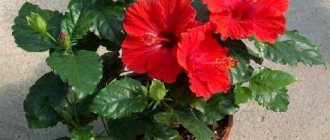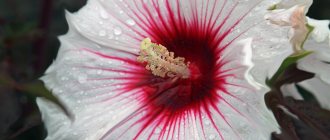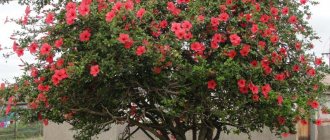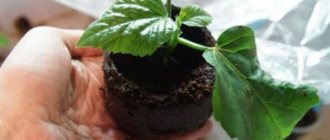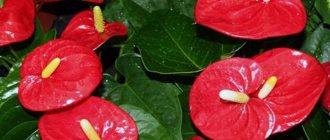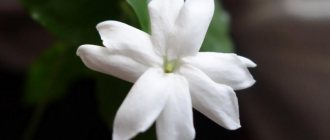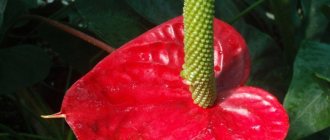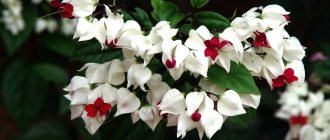Chinese rose (or hibiscus, as well as Indian or Tea rose) is a species of plant of the genus Rosehip, family Rosaceae. This flower comes from China. It is not found in the wild, but is very popular in indoor floriculture - tea rose buds are often used as tea leaves, which are used to make aromatic, invigorating tea.
While waiting for flowers, novice gardeners unknowingly pamper the plant, trying to create the most comfortable conditions for it: they fertilize it abundantly, place it in the sun, and provide regular and frequent watering. This is why many are perplexed when a rose does not want to bloom, despite all efforts.
Chinese rose
Most often, the reason for this is ignorance of the features of caring for Chinese roses at home.
About caring for Chinese roses at home
When caring for a plant in a house or apartment, you should pay attention to the following conditions for keeping the flower:
- frequency of irrigation and water quality;
- degree of illumination;
- regularity of feeding;
- need for pruning;
- temperature regime;
- location of the plant indoors;
- soil type.
Features of watering
It is necessary to water the Chinese rose once every 3-4 days, and the water for watering should not be cold. The optimal temperature of irrigation water is about 30 °C. The rose can also be sprayed and wiped with leaves of the plant, especially in hot weather. To increase air humidity, small containers of water are placed next to the rose. In conditions of high humidity, it is recommended to ventilate the room in which the flower is located more often.
Chinese rose
In winter, moisture stagnation as a result of frequent watering is especially dangerous. In hot weather, on the contrary, it is better not to spare water, but the next watering is carried out only when the top layer of soil is completely dry. In addition, the water used for irrigation must be soft.
Important! You can determine the quality of water by boiling - a film appears on the surface of hard water.
Illumination level
Full development of a flower is impossible without observing lighting conditions. Hibiscus grows well in partial shade, but will not set buds. On the other hand, direct sunlight causes burns to rose leaves. It is best to position the plant so that it is in diffused lighting conditions.
How and what to feed
For proper development of the plant, moderate feeding is necessary. Excessive enrichment or poor soil is equally harmful to the Chinese rose.
Specialized complex mineral fertilizers
During the period of active growth (March-September), flowers are fed every week. During the rest period (October-February), the frequency of feeding is reduced to once a month. It is recommended to use specialized complex mineral fertilizers as top dressing.
Important! Enriching the soil with nitrogen only stimulates leaf growth, while phosphate fertilizing promotes abundant flowering.
Trimming
You can “make” a Chinese rose bloom using the pruning procedure. Hibiscus flowers form only on young shoots, so pruning the plant helps the buds form.
Pruning is done before the hibiscus awakens.
Temperature
In the winter months, it is necessary to provide conditions for the rose to go into hibernation, which is impossible at temperatures above +13˚C. In addition, at this time it is advisable not to feed the plant and keep watering to a minimum.
Sudden changes in dormant temperature can also affect a flower's ability to set buds.
Rearrangement
Hibiscus does not respond well to frequent rearrangements. Changes in microclimate cause stress to the plant, which may begin to wither, and minor mechanical damage leads to the fact that the rose begins to shed leaves and flowers. Even a slight sway of the branches is enough.
Hibiscus does not respond well to frequent rearrangements.
Soil type
Hibiscus is a rather capricious plant, demanding on the type of soil. It grows well only in fertile, loose soil mixtures with moderate acidity. To improve the composition of the soil, you can fertilize it with coal chips or humus.
Briefly about hibiscus: flowering, planting
The height of the bush with good care can reach 3 m or more. Its branchiness is increased by proper pruning. The life span of hibiscus is between 15-20 years.
The diameter of huge flowers often approaches 12 cm, but there are varieties whose inflorescences are more than 16 cm in diameter. The color palette is quite extensive, but the most common are shrubs with red, purple and white buds. After planting the crop, you will have to wait 3-4 years until the first bud appears and the flower opens. And after transplanting the finished seedling, flowering begins a year later.
Interesting! Each flower pleases the eye for a day, then fades and falls. A new bud appears almost immediately, creating the appearance of continuous flowering.
Hibiscus
How and when does hibiscus bloom?
A plant grown from seeds opens its first corollas 3-4 years after germination. The cuttings can produce buds not yet fully rooted - in water, perlite, or a peat-sand mixture. It cannot be allowed to bloom, otherwise it will take a long time to produce lower shoots and perhaps disappear.
With good care, Chinese rose blooms from spring to autumn, 8-10 months a year. If the maintenance is generally correct, but the owners do not take very good care of the plant, the bush, regardless of the season, continuously produces buds for 2-3 months. Then it gains strength and sometimes blooms again.
You can find statements that hibiscus is at its peak of decorative value from June or July to September. Indeed, in many homes culture blooms at this time, even with ideal care. The reason is that the owners do the pruning too late, when new leaves have already blossomed. This delays the formation of buds by 3 months.
Each whisk lasts from 1 to 3 days. The Chinese rose fades most quickly in the heat - the flower bloomed in the morning and wilted in the evening. The corollas of terry varieties are preserved for a long time or in cloudy, cool weather.
buds
Hibiscus inflorescences are characterized by an exotic appearance and large size: fully opened buds are 9-16 cm in diameter.
The flower shape is cup-shaped, the inflorescences are either simple or double. In the center of each flower there is a pistil, which turns into stamens.
The vast majority of varieties of Chinese roses have flowers without any aroma, but there are also specimens with fragrant buds.
Typically, hibiscus flowers open in the morning, at sunrise, and wilt in the evening. With proper care, one branch can produce about 20 inflorescences during the day; on some large plants, up to 50 flowers can bloom simultaneously.
Rest period
The dormant period of the Chinese rose lasts from November to February. During these months, the plant is best kept at temperatures from +14°C to +16. During its dormant period, the hibiscus should receive enough light and moisture: a good level of lighting and moderate watering should be provided. It should be disturbed minimally at this time so that the plant can rest, gain strength and prepare for flowering.
The laying of new buds on Chinese roses occurs at a temperature no higher than +15°C. In February, hibiscus is placed closer to warmth and light, and the number of fertilizing and waterings is gradually increased.
You can also send roses for the winter by pruning them first. To do this, you need to give it the opportunity to shed its leaves in the fall. For this purpose, watering is gradually reduced to a minimum. When the hibiscus leaves fall, the stems are carefully trimmed, leaving “stumps” 6-8 cm long. Then the plant is transferred to a cool place (the ambient temperature should not be higher than +12°C). To prevent the root system of the Chinese rose from drying out, the soil must be slightly moistened from time to time.
Why does the Chinese rose not bloom at home?
Chinese rose: home care
There are many reasons why the Chinese rose does not bloom at home. Balance is the most important condition for the proper development of a flower. Therefore, it is customary to highlight the following reasons why a rose stops blooming:
- excess or lack of sunlight;
- frequent rearrangement of plants from place to place;
- excessive enrichment of the soil with fertilizers or its depletion;
- lack of timely pruning;
- sudden changes in temperature;
- too rare or, conversely, too frequent watering.
Note! In addition, it is especially worth highlighting the damage to roses by fungal diseases and pests.
What does the plant look like?
Hibiscus is an evergreen or deciduous plant that can be a shrub or even a tree. The leaves grow alternately on petioles. The flowers are large, brightly colored, located at the top of the shoot, and have more than three sub-cup leaves. The plant can bloom in almost any color except black or blue.
Depending on the species, the flower can reach up to 30 cm. Its fruit has the shape of a box containing seeds. A rose bush can live up to 20 years. In favorable conditions, it can grow up to three meters high.
Chinese rose (Hibiscus rosa-sinensis) is considered the most popular species for growing indoors. It grows in the form of a bush and has red, large, double flowers.
Methods of controlling infections and pests
Of particular danger to this species are:
- aphids are a rapidly multiplying harmful insect that settles on roses on the underside of the leaves;
- spider mite is a small insect of light green color with black spots;
- powdery mildew or downy mildew - the first signs of the disease are brown spots on the leaves of hibiscus, which lead to the leaves beginning to fall off;
- spotting - manifests itself in the form of rotting spots with an oily border.
Chinese rose (flower of death): why you can’t keep it in the house
In the case of insects, it will be sufficient to treat the plant with any insecticide or acaricide. When there are too many pests, Actellik is used. Dosage: 15 drops of product per 1 liter of water. Korbofos and Metathion are also suitable. A weak solution of kerosene is no less effective.
Drugs such as Acrex, Omite, Actofit or Isofen can help in the fight against spider mites.
Important! The instructions for the drugs will say that they need to be used repeatedly. Why - newbies ask. The fact is that these chemicals only affect adults, without causing any harm to the eggs, so a one-time spraying will not give the desired result. To get rid of the pest, roses are sprayed about 5 times every 2-3 days.
If desired, chemicals can be replaced with a soap solution with pepper, which has a more gentle effect on the flower.
If spotting is detected, the rose is treated with Cumulus or Rovral. In case of chlorosis, hibiscus is sprayed with iron chelate and the flower is fed with organic matter.
Superstitions and growing tips
In Asian countries, hibiscus has long been treated with respect. In the East, it was believed that the Chinese rose spreads vital energy, patronizes business, and preserves the family hearth. A flowering plant is associated with the element of fire and passion, and therefore strengthens marriage.
Since ancient times, the healing properties of this plant have been valued. Tea made from its flowers (hibiscus) is recommended as a tonic, refreshing, healthy drink. There is a strong belief that hibiscus has a beneficial effect on indoor living spaces, refreshing the air and strengthening weak plants.
In Hawaii, this plant is called the flower of beautiful women who decorate their hair with it. In Brazil it is called “princess earrings”, and in India – “flower of love”.
Hibiscus has gained wide popularity among amateur gardeners who put their whole soul into growing these plants. Many experts can share valuable secrets and recommendations with the help of which even a beginner will achieve good results.
Hibiscus is a versatile plant that can exist as bushes and small trees. Any of its varieties is distinguished by its unpretentiousness, colorful and unique flowering for a long time.
Prevention
Why doesn't the rose bloom?
It is always better to prevent a disease than to treat it. In most cases, problems associated with the fact that a rose does not want to bloom arise due to improper care and inattention, therefore timely and correct implementation of agricultural techniques is used as a disease prevention.
It is necessary to inspect the plant from time to time and remove leaves from the pot.
Since the main reason for the appearance of pests is increased dry air, prevention against insects involves moderate air humidification. The pot with the rose is placed on a small tray with a wet stone, and the hibiscus leaves are periodically sprayed with settled water. In addition, it is necessary to inspect the plant from time to time and remove leaves from the pot that have fallen. This will create unfavorable conditions for pests.
Diseases, on the contrary, are most often caused by high soil and air humidity. To reduce the risk of roses being damaged by fungal diseases, it is enough to maintain optimal air humidity in the room. Also, as a preventative measure, rose bushes can be sprayed with any brand of fungicide.
Sometimes attempts to provide maximum comfort to a plant can lead to inhibition of its development or even death. Too much care is just as harmful as too little care, so it is important to maintain a balance when caring for Chinese roses. Moderate feeding, rest in winter, timely pruning and protection from drafts - that’s all a flower needs for proper development and abundant flowering.
0 0 votes
Article rating
General information about the flower
Garden or park roses are unpretentious flowering crops. But still, this beautiful plant requires certain care and compliance with certain maintenance conditions. This is necessary so that the rose delights passers-by with its magnificent appearance and aroma.
Only a healthy shrub will delight its owners with large flowers and their quantity.
A healthy and strong bush with flowers will become a real decoration of the garden, park and home area. Seedlings can be purchased at a nursery or existing plants can be propagated. These activities do not require special knowledge.
The rose blooms profusely and for a long time; there are varietal representatives that can produce flower buds twice per season. True, repeated flowering will not be so beautiful: the flowers will be much smaller.
Important! The plant must be pruned regularly. This will form the correct crown, otherwise the bush will not grow in height. The branches will stretch and spoil the appearance of the plant.
Do not worry if only the planted young plant does not bloom; buds will begin to set in the second year after planting in open ground
Shrub of the malvaceae family
The homeland of hibiscus is northern Indochina. Over time, the shrub began to spread in regions with tropical and subtropical climates; it began to be grown in park areas and gardens. For 8 months, it continuously pleases the eye with a scattering of white, orange, yellow, crimson and scarlet inflorescences.
Chinese rose is grown in harsh and temperate climates, in greenhouses and apartments. Experienced and novice flower growers love roses for their combination of unpretentiousness with an extraordinary decorative effect. The sharp color contrast between the glossy dark green foliage and vibrant flowers is a real delight.
The shrub has a lush crown, which, with proper care, can reach three meters in height. The flowers are funnel-shaped, large, up to 15 cm. Double and semi-double flowers take a long time to bloom, but remain open for only a few days.
The plant is light and moisture loving. If the ground dries out, the Chinese rose sheds its leaves. For the plant to feel good, it needs to be sprayed regularly and placed on a tray with water. Roses tolerate light partial shade well, but in this case they will bloom less. Indoor Chinese rose blooms from early summer to autumn.
Large funnel-shaped flowers are held on a long stalk. The inflorescence is formed from five petals collected in a tube around a golden stamen. Flowers bloom at dawn, and by sunset the petals begin to fall. Many varieties are odorless; only some white inflorescences emit a subtle and delicate aroma. A medium-sized shrub can produce up to 20, and a large plant - up to 50 inflorescences.
Description
Including about two hundred species, the genus of hibiscus, wild and “domesticated”, is quite extensive and is represented by various plants - trees, shrubs, perennial and annual herbs. The basis of the genus is still made up of woody shrubs - decorative, flowering and striking with solemnity and splendor. This is exactly how Russian flower growers know this plant, calling it Chinese rose and successfully growing it at home. In nature, hibiscus grows in the humid tropics and subtropics, often forming lush flowering thickets.
The predilection for the abundance of moisture in these plants has given rise to another unofficial name that emphasizes their characteristics - marsh mallow.
Large, exquisite flowers with bright, graceful corollas that bloom at the ends of the shoots are very beautiful. They made the plant a national symbol of Hawaii and a particularly revered crop in many countries in East Asia and South America. Dark green leaves of varying degrees of incision, dense and petiolate, support the decorative appearance of the plant. The fruit is a capsule, split into several valves, containing many seeds, smooth or slightly pubescent.
Hibiscus, the photo of which is presented in the publication, is not only decorative, but also useful. Young leaves and stems of many plant species are eaten, and seeds, fruits and roots serve as raw materials in pharmacology, medicine, perfumery. We will learn the features of growing crops in the home and garden.
